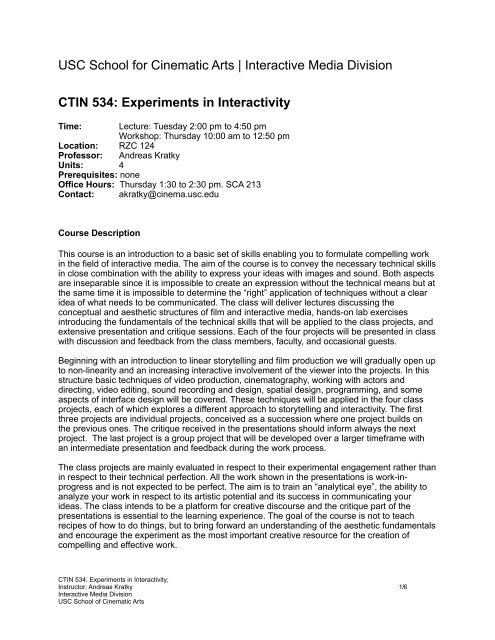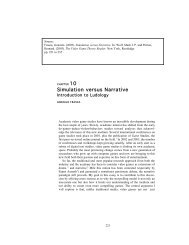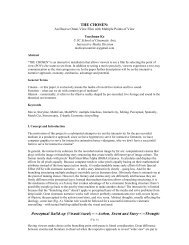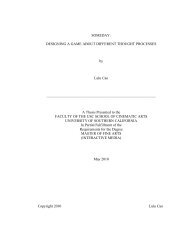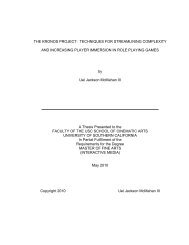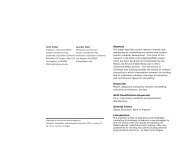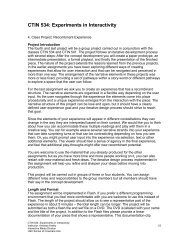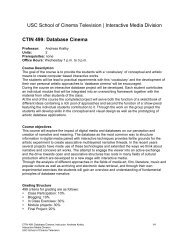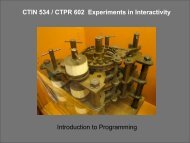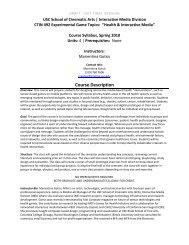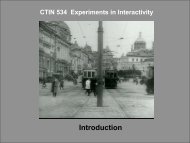CTIN 534: Experiments in Interactivity - USC Interactive Media Division
CTIN 534: Experiments in Interactivity - USC Interactive Media Division
CTIN 534: Experiments in Interactivity - USC Interactive Media Division
Create successful ePaper yourself
Turn your PDF publications into a flip-book with our unique Google optimized e-Paper software.
<strong>USC</strong> School for C<strong>in</strong>ematic Arts | <strong>Interactive</strong> <strong>Media</strong> <strong>Division</strong><br />
<strong>CTIN</strong> <strong>534</strong>: <strong>Experiments</strong> <strong>in</strong> <strong>Interactivity</strong><br />
Time: Lecture: Tuesday 2:00 pm to 4:50 pm<br />
Workshop: Thursday 10:00 am to 12:50 pm<br />
Location: RZC 124<br />
Professor:<br />
Units: 4<br />
Prerequisites: none<br />
Andreas Kratky<br />
Office Hours: Thursday 1:30 to 2:30 pm. SCA 213<br />
Contact: akratky@c<strong>in</strong>ema.usc.edu<br />
Course Description<br />
This course is an <strong>in</strong>troduction to a basic set of skills enabl<strong>in</strong>g you to formulate compell<strong>in</strong>g work<br />
<strong>in</strong> the field of <strong>in</strong>teractive media. The aim of the course is to convey the necessary technical skills<br />
<strong>in</strong> close comb<strong>in</strong>ation with the ability to express your ideas with images and sound. Both aspects<br />
are <strong>in</strong>separable s<strong>in</strong>ce it is impossible to create an expression without the technical means but at<br />
the same time it is impossible to determ<strong>in</strong>e the “right” application of techniques without a clear<br />
idea of what needs to be communicated. The class will deliver lectures discuss<strong>in</strong>g the<br />
conceptual and aesthetic structures of film and <strong>in</strong>teractive media, hands-on lab exercises<br />
<strong>in</strong>troduc<strong>in</strong>g the fundamentals of the technical skills that will be applied to the class projects, and<br />
extensive presentation and critique sessions. Each of the four projects will be presented <strong>in</strong> class<br />
with discussion and feedback from the class members, faculty, and occasional guests.<br />
Beg<strong>in</strong>n<strong>in</strong>g with an <strong>in</strong>troduction to l<strong>in</strong>ear storytell<strong>in</strong>g and film production we will gradually open up<br />
to non-l<strong>in</strong>earity and an <strong>in</strong>creas<strong>in</strong>g <strong>in</strong>teractive <strong>in</strong>volvement of the viewer <strong>in</strong>to the projects. In this<br />
structure basic techniques of video production, c<strong>in</strong>ematography, work<strong>in</strong>g with actors and<br />
direct<strong>in</strong>g, video edit<strong>in</strong>g, sound record<strong>in</strong>g and design, spatial design, programm<strong>in</strong>g, and some<br />
aspects of <strong>in</strong>terface design will be covered. These techniques will be applied <strong>in</strong> the four class<br />
projects, each of which explores a different approach to storytell<strong>in</strong>g and <strong>in</strong>teractivity. The first<br />
three projects are <strong>in</strong>dividual projects, conceived as a succession where one project builds on<br />
the previous ones. The critique received <strong>in</strong> the presentations should <strong>in</strong>form always the next<br />
project. The last project is a group project that will be developed over a larger timeframe with<br />
an <strong>in</strong>termediate presentation and feedback dur<strong>in</strong>g the work process.<br />
The class projects are ma<strong>in</strong>ly evaluated <strong>in</strong> respect to their experimental engagement rather than<br />
<strong>in</strong> respect to their technical perfection. All the work shown <strong>in</strong> the presentations is work-<strong>in</strong>progress<br />
and is not expected to be perfect. The aim is to tra<strong>in</strong> an “analytical eye”, the ability to<br />
analyze your work <strong>in</strong> respect to its artistic potential and its success <strong>in</strong> communicat<strong>in</strong>g your<br />
ideas. The class <strong>in</strong>tends to be a platform for creative discourse and the critique part of the<br />
presentations is essential to the learn<strong>in</strong>g experience. The goal of the course is not to teach<br />
recipes of how to do th<strong>in</strong>gs, but to br<strong>in</strong>g forward an understand<strong>in</strong>g of the aesthetic fundamentals<br />
and encourage the experiment as the most important creative resource for the creation of<br />
compell<strong>in</strong>g and effective work.<br />
<strong>CTIN</strong> <strong>534</strong>: <strong>Experiments</strong> <strong>in</strong> <strong>Interactivity</strong>;<br />
Instructor: Andreas Kratky 1/6<br />
<strong>Interactive</strong> <strong>Media</strong> <strong>Division</strong><br />
<strong>USC</strong> School of C<strong>in</strong>ematic Arts
The work <strong>in</strong> <strong>CTIN</strong> <strong>534</strong> is done <strong>in</strong> a group where everybody helps everybody with feedback and<br />
skills. Collaboration and exchange at every stage of the projects are highly encouraged.<br />
Course objectives<br />
• Investigate the aesthetic potential of images, sound, and <strong>in</strong>teractivity.<br />
• Develop and sharpen your ability to formulate your ideas and communicate them<br />
effectively with visual media<br />
• Experiment with different approaches to narrative and <strong>in</strong>teractivity<br />
• Formulate constructive criticism and use the feedback you receive from others to<br />
analyze and sharpen your work<br />
• Understand the relationship between form and content<br />
• Understand the relationship between storytell<strong>in</strong>g and <strong>in</strong>teractivity<br />
• Develop fundamental skills <strong>in</strong> the areas of technical knowledge taught <strong>in</strong> the course<br />
Course projects<br />
1. Project:<br />
Realize a short l<strong>in</strong>ear film: This project will be a first exercise to apply what has been learned<br />
about camera handl<strong>in</strong>g, c<strong>in</strong>ematography and edit<strong>in</strong>g. For this project you will have to conceive a<br />
simple story that develops over the course of a l<strong>in</strong>ear film. The “mental <strong>in</strong>teraction” of the viewer<br />
is a po<strong>in</strong>t of particular <strong>in</strong>terest <strong>in</strong> this project, engag<strong>in</strong>g the viewer and play<strong>in</strong>g with his<br />
expectations.<br />
2. Project:<br />
Realize of a film with a non-l<strong>in</strong>ear structure: Explore the possibilities of multiple <strong>in</strong>terwoven<br />
story-threads and a flexible temporal structure that can be navigated by the viewer. For this<br />
project you should use the footage produced for the first project, possibly extended with some<br />
new footage, and edit it <strong>in</strong> a way that experiments with aspects of non-l<strong>in</strong>earity. A po<strong>in</strong>t of<br />
particular <strong>in</strong>terest <strong>in</strong> this project is the question of the relationship between the different<br />
storyl<strong>in</strong>es and how they form an experience as a whole. Consider different k<strong>in</strong>ds of choice and<br />
how the choice is offered and communicated to the viewer.<br />
3. Project:<br />
Realize an experience with a navigable spatial structure: Create a geographic space that the<br />
viewer can explore by navigat<strong>in</strong>g <strong>in</strong> different directions. The path that the viewer takes <strong>in</strong> this<br />
space should be a comprehensive narrative experience. The ma<strong>in</strong> question addressed <strong>in</strong> this<br />
project is the collaboration of the author with the viewer: How to create a mean<strong>in</strong>gful and legible<br />
experience while at the same time lett<strong>in</strong>g the viewer decide by himself <strong>in</strong> which direction to<br />
proceed and where to look.<br />
4. Project:<br />
Realize an <strong>in</strong>teractive experience with a recomb<strong>in</strong>ant structure: Build the experience out of<br />
elements that can be read and re-<strong>in</strong>terpreted <strong>in</strong> different ways depend<strong>in</strong>g on the navigation of<br />
the viewer. In order to communicate the choices and consequences of the navigational<br />
decisions to the viewer you should design a custom-made user <strong>in</strong>terface that becomes an<br />
<strong>in</strong>tegral part of the experience. This project is a group project.<br />
<strong>CTIN</strong> <strong>534</strong>: <strong>Experiments</strong> <strong>in</strong> <strong>Interactivity</strong>;<br />
Instructor: Andreas Kratky 2/6<br />
<strong>Interactive</strong> <strong>Media</strong> <strong>Division</strong><br />
<strong>USC</strong> School of C<strong>in</strong>ematic Arts
Read<strong>in</strong>gs<br />
Several lectures have read<strong>in</strong>g assignments. The read<strong>in</strong>gs are required <strong>in</strong> preparation of the<br />
class meet<strong>in</strong>g they are listed for.<br />
Grad<strong>in</strong>g Structure<br />
<strong>CTIN</strong> <strong>534</strong> criteria for grad<strong>in</strong>g are as follows:<br />
• Class participation: 5%<br />
• In-class exercises: 15%<br />
• Each of the four class projects: 20%<br />
Two missed classes without excuse as well as three times be<strong>in</strong>g late for class without excuse<br />
will reduce the grade.<br />
Miss<strong>in</strong>g an Exam, Incompletes:<br />
The grad<strong>in</strong>g of this course is based ma<strong>in</strong>ly on the projects that are completed and presented<br />
throughout the course of the class (see the grad<strong>in</strong>g section of this syllabus). There are no<br />
particular mid-term or f<strong>in</strong>al exams but the presentation of the projects on the scheduled dates<br />
plays the same role and is mandatory. The only acceptable excuses for miss<strong>in</strong>g a presentation<br />
or tak<strong>in</strong>g an <strong>in</strong>complete <strong>in</strong> the course are personal illnesses or a family emergency. Incompletes<br />
may only be given after the twelfth week of classes. Students must <strong>in</strong>form the professor before<br />
the project presentation and present verifiable evidence <strong>in</strong> order for a make-up to be scheduled.<br />
Students who wish to take <strong>in</strong>completes must also present documentation of the problem to the<br />
<strong>in</strong>structor before f<strong>in</strong>al grades are due.<br />
Mid-term Conferences<br />
These conferences allow you to get a sense of your overall progress, areas for improvement<br />
and an estimated grade at mid-po<strong>in</strong>t <strong>in</strong> the semester. If you are <strong>in</strong> danger of fail<strong>in</strong>g, you will be<br />
alerted <strong>in</strong> writ<strong>in</strong>g and <strong>in</strong> a conference; we will outl<strong>in</strong>e together what steps must be taken <strong>in</strong> order<br />
for you to pass. It is the student's responsibility to be aware of <strong>USC</strong>'s add/drop and withdrawal<br />
deadl<strong>in</strong>es.<br />
Academic Integrity<br />
The School of C<strong>in</strong>ematic Arts expects the highest standards of academic excellence and ethical<br />
performance from <strong>USC</strong> students. It is particularly important that you are aware of and avoid<br />
plagiarism, cheat<strong>in</strong>g on exams, submitt<strong>in</strong>g a paper to more than one <strong>in</strong>structor, or submitt<strong>in</strong>g a<br />
paper authored by anyone other than yourself. Violations of this policy will result <strong>in</strong> a fail<strong>in</strong>g<br />
grade and be reported to the Office of Student Judicial Affairs. If you have any doubts or<br />
questions about these policies, consult “SCAMPUS” and/or confer with the Professor or<br />
Department Chair. The Student Conduct Code can be found <strong>in</strong> Section 11.00. Recommended<br />
sanctions are located <strong>in</strong> Appendix A: http://www.usc.edu/dept/publications/SCAMPUS.gov<br />
<strong>CTIN</strong> <strong>534</strong>: <strong>Experiments</strong> <strong>in</strong> <strong>Interactivity</strong>;<br />
Instructor: Andreas Kratky 3/6<br />
<strong>Interactive</strong> <strong>Media</strong> <strong>Division</strong><br />
<strong>USC</strong> School of C<strong>in</strong>ematic Arts
Students with Disabilities<br />
Any student request<strong>in</strong>g academic accommodations based on a disability is required to register<br />
with Disability Services and Programs (DSP) each semester. A letter of verification for approved<br />
accommodations can be obta<strong>in</strong>ed from DSP. Please be sure that the letter is delivered to the<br />
Professor as early <strong>in</strong> the semester as possible.<br />
DSP is located <strong>in</strong> STU 301 and is open 8:30am – 5:00pm, Monday through Friday.<br />
The phone number for DSP is (213) 740-0776.<br />
Course Outl<strong>in</strong>e:<br />
1. Week<br />
• Aug 28, 2012: Introduction<br />
Overview over course structure<br />
Discussion of different narrative structures<br />
Set-up of lab and equipment access<br />
• Aug 30, 2012: Camera 1: Introduction of camera operation and check out procedure<br />
Assignment: First camera experiments (fulfill shot list)<br />
Introduction of first project<br />
2. Week<br />
• Sept 4, 2012: Camera 2: Lecture and discussion of image aesthetics and shot<br />
composition.<br />
Review of first experiments with the camera (camera 1 assignment)<br />
• Sept 6, 2012: Lecture and discussion of concepts of visual storytell<strong>in</strong>g and montage<br />
Assignment: Camera experiments 2 (shoot short non-narrative<br />
sequence)<br />
Read<strong>in</strong>g: Sergei Eisenste<strong>in</strong>: A Dialectic Approach to Film Form; <strong>in</strong>:<br />
Eisenste<strong>in</strong>, S., Film Form, 1977<br />
3. Week<br />
• Sept 11, 2012: Review of non-narrative sequence (camera 2 assignment)<br />
Introduction to edit<strong>in</strong>g<br />
• Sept 13, 2012: Guest lecture by Norman Hollyn: Shap<strong>in</strong>g Story<br />
4. Week<br />
• Sept 18, 2012: First project due<br />
Screen<strong>in</strong>g and discussion of the first project (Group A)<br />
• Sept 20, 2012: Screen<strong>in</strong>g and discussion of the first project (Group B)<br />
<strong>CTIN</strong> <strong>534</strong>: <strong>Experiments</strong> <strong>in</strong> <strong>Interactivity</strong>;<br />
Instructor: Andreas Kratky 4/6<br />
<strong>Interactive</strong> <strong>Media</strong> <strong>Division</strong><br />
<strong>USC</strong> School of C<strong>in</strong>ematic Arts
5. Week<br />
• Sept 25, 2012: Lecture and discussion of non-l<strong>in</strong>ear narrative and variable narrative<br />
Structures. Introduction of second project<br />
Read<strong>in</strong>g: Italo Calv<strong>in</strong>o, Cybernetics and Ghosts; <strong>in</strong>: Calv<strong>in</strong>o, I., The Uses<br />
of Literature, 1986<br />
• Sept 27, 2012: Introduction to the programm<strong>in</strong>g of simple <strong>in</strong>teractive structures <strong>in</strong><br />
html 5<br />
6. Week<br />
• Oct 2, 2012: Light<strong>in</strong>g exercise: Different moods and expressions (Sound stage)<br />
• Oct 4, 2012: Introduction to c<strong>in</strong>ematography; guest lecture by Angelo Pacifici<br />
7. Week<br />
• Oct 9, 2012: Second project due<br />
Screen<strong>in</strong>g and discussion of the second project (Group A)<br />
• Oct 11, 2012: Screen<strong>in</strong>g and discussion of the second project (Group B)<br />
8. Week<br />
• Oct 16, 2012: Lecture and discussion of concepts of <strong>in</strong>teractivity, the relationship<br />
between author and viewer and storyboard<strong>in</strong>g for <strong>in</strong>teractivity<br />
Introduction of third project<br />
Read<strong>in</strong>g: Espen Arseth, Allegories of Space; <strong>in</strong> Cybertext Yearbook 2000<br />
• Oct 18, 2012: General <strong>in</strong>troduction <strong>in</strong>to programm<strong>in</strong>g and overview over different<br />
programm<strong>in</strong>g environments<br />
9. Week<br />
• Oct 23, 2012: Unity 3d 1: Introduction to the Unity 3d author<strong>in</strong>g environment<br />
• Oct 25, 2012: Unity 3d 2: Cont<strong>in</strong>uation of <strong>in</strong>tro to Unity 3d author<strong>in</strong>g environment<br />
10. Week<br />
• Oct 30, 2012: Third project due<br />
Screen<strong>in</strong>g and discussion of third project (Group A)<br />
• Nov 1, 2012: Screen<strong>in</strong>g and discussion of third project (Group B)<br />
11. Week<br />
• Nov 6, 2012: Lecture and discussion of recomb<strong>in</strong>ant and procedural experiences<br />
Introduction of the fourth project<br />
Read<strong>in</strong>g: Umberto Eco, The Open Work; chapter 1<br />
<strong>CTIN</strong> <strong>534</strong>: <strong>Experiments</strong> <strong>in</strong> <strong>Interactivity</strong>;<br />
Instructor: Andreas Kratky 5/6<br />
<strong>Interactive</strong> <strong>Media</strong> <strong>Division</strong><br />
<strong>USC</strong> School of C<strong>in</strong>ematic Arts
• Nov 8, 2012: Lecture and discussion of visual design concepts, <strong>in</strong>terface, and<br />
experience design<br />
12. Week<br />
• Nov 13, 2012: Introduction to sound record<strong>in</strong>g and location sound; guest lecture by<br />
Midge Cost<strong>in</strong><br />
• Nov 15, 2012: Introduction to sound design<br />
Read<strong>in</strong>g: Douglas Kahn, Listen<strong>in</strong>g Through History; <strong>in</strong> Kahn, D.<br />
Noise Water Meat, 2001<br />
13. Week<br />
• Nov 20, 2012: Intermediate screen<strong>in</strong>g of fourth project (Group A)<br />
• Nov 22, 2012: Thanksgiv<strong>in</strong>g<br />
14. Week<br />
• Nov 27, 2012: Intermediate screen<strong>in</strong>g of fourth project (Group B)<br />
• Nov 29, 2012: Introduction to non-traditional <strong>in</strong>terfaces<br />
Class evaluation<br />
15. Week<br />
• Dec 4, 2012: Fourth project due<br />
Screen<strong>in</strong>g and discussion of fourth project (Group A)<br />
• Dec 6, 2012: Screen<strong>in</strong>g and discussion of fourth project (Group B)<br />
Class round-up<br />
<strong>CTIN</strong> <strong>534</strong>: <strong>Experiments</strong> <strong>in</strong> <strong>Interactivity</strong>;<br />
Instructor: Andreas Kratky 6/6<br />
<strong>Interactive</strong> <strong>Media</strong> <strong>Division</strong><br />
<strong>USC</strong> School of C<strong>in</strong>ematic Arts


